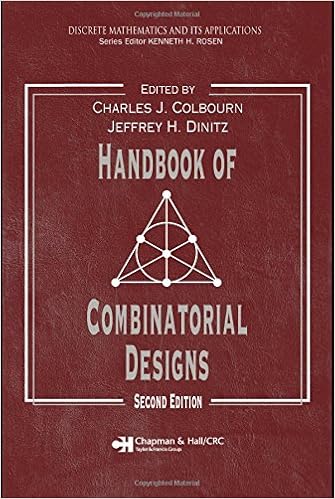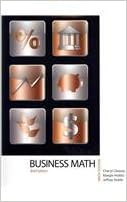
Carrying on with within the bestselling, informative culture of the 1st version, the Handbook of Combinatorial Designs, moment Edition is still the one source to comprise all the most vital effects and tables within the box of combinatorial layout. This guide covers the structures, homes, and purposes of designs in addition to lifestyles results.
Over 30% longer than the 1st version, the booklet builds upon the basis of its predecessor whereas keeping the unique individuals' services. the 1st half encompasses a short advent and historical past of the topic. the subsequent elements specialize in 4 major periods of combinatorial designs: balanced incomplete block designs, orthogonal arrays and Latin squares, pairwise balanced designs, and Hadamard and orthogonal designs. heavily hooked up to the previous sections, the subsequent half surveys sixty five extra periods of designs, akin to balanced ternary, factorial, graphical, Howell, quasi-symmetric, and round. the ultimate half offers mathematical and computational historical past concerning layout theory.
New to the second one Edition
Meeting the necessity for up to date and obtainable tabular and reference info, this guide offers the instruments to appreciate combinatorial layout thought and functions that span the whole discipline.
the writer keeps an internet site with extra information.
Read or Download Handbook of Combinatorial Designs, Second Edition (Discrete Mathematics and Its Applications) PDF
Similar Mathematics books
Schaum's Outline of Abstract Algebra (Schaum's Outlines)
Difficult try out Questions? ignored Lectures? no longer Rnough Time? thankfully for you, there is Schaum's Outlines. greater than forty million scholars have depended on Schaum's to assist them achieve the school room and on tests. Schaum's is the most important to quicker studying and better grades in each topic. each one define offers all of the crucial path details in an easy-to-follow, topic-by-topic structure.
Algebra DeMYSTiFieD (2nd Edition)
Your technique to studying ALGEBRA!
Trying to take on algebra yet nothing's including up?
No challenge! consider Algebra Demystified, moment version and multiply your probabilities of studying this crucial department of arithmetic. Written in a step by step structure, this useful advisor covers fractions, variables, decimals, unfavorable numbers, exponents, roots, and factoring. concepts for fixing linear and quadratic equations and purposes are mentioned intimately. transparent examples, concise factors, and labored issues of entire strategies make it effortless to appreciate the cloth, and end-of-chapter quizzes and a last examination aid make stronger learning.
It's a no brainer!
You'll find out how to:
• Translate English sentences into mathematical symbols
• Write the unfavourable of numbers and variables
• issue expressions
• Use the distributive estate to extend expressions
• remedy utilized difficulties
Simple adequate for a newbie, yet tough sufficient for a sophisticated scholar, Algebra Demystified, moment version is helping you grasp this crucial math topic. It's additionally the best source for getting ready you for larger point math sessions and school placement assessments.
Business Mathematics, Brief Edition with MyMathLab/MyStatLab and Study Guide (9th Edition)
This package deal comprises the subsequent elements: -0132111748: company arithmetic, short version -0135027039: MyMathLab/MyStatLab -013211173X: research consultant for company arithmetic whole and short variations
The realm round us is saturated with numbers. they're a primary pillar of our smooth society, and authorized and used with rarely a moment concept. yet how did this scenario end up? during this ebook, Leo Corry tells the tale in the back of the belief of quantity from the early days of the Pythagoreans, up until eventually the flip of the 20th century.
Additional info for Handbook of Combinatorial Designs, Second Edition (Discrete Mathematics and Its Applications)
1. . . 484} lim = 484, [2159, 1338, 289, 753], Theorem four. sixteen. {m = 2n, 1 ≤ n ≤ 484} ∪ {3} ∪ {m = 6n + three, three ≤ n ≤ a hundred and sixty} ∪ {969} lim = 969, [1783, 289], Theorems four. sixteen, four. 18. {1,2, four. . . 322} lim = 323, [289, 753], Theorem four. sixteen. {2,4. . . 323} lim = 323, [289, 753], Theorem four. sixteen. List(5, 12, 24) lim = 4199. {1. . . nine} lim = nine, Theorem four. eight. {1. . . 28} lim = 28, Theorem four. eight. {1. . . 484} lim = 484, Theorem four. sixteen. {1,2, 6. . . 233} lim = 323, Theorems four. eight, four. sixteen. {2,4. . . 323} lim = 323, Theorems four. eight, four. sixteen. List(5, eleven, 24)∪List(5, 12, 25)∪List(5, eleven, 25) lim = 323, Theorem four. sixteen. List(5, 12, 24)) lim = 4199, Theorem four. sixteen. {1, 2, three} lim = three, Theorem four. 20. {1} lim = 1, [1352]. (See instance four. 21. ) {1} lim = 1, [333]. {2, three} lim = three, Theorems four. 20, four. 18. {1} lim = 1, [2069]. {3, four, five} lim = five, D16 , [333], Theorem four. sixteen. {3, four, five} lim = five, HOL(C16 ), HOL(C8 ) × C2 , [333]. {4. . . sixteen} lim = sixteen, Theorem four. 20. {2. . . five} lim = five, [333, 2069]. {3, four, five} lim = five, [2069, 1333]. {4, five, 6} lim = 6, [333, 1333], Theorem four. sixteen. {1. . . 6} lim = 6, [1333]. 88 t-Designs with t ≥ three 5-(18, eight, m2) 5-(18, nine, m5) 5-(19, 6, m2) 5-(19, 7, m7) 5-(19, eight, m28) 5-(19, nine, m7) 5-(20, eight, m35) 5-(20, nine, m105) 5-(20, 10, m21) 5-(21, 6, m4) 5-(21, 7, m30) 5-(21, eight, m280) 5-(21, nine, m70) 5-(21, 10, m168) 5-(22, 6, m) 5-(22, 7, m2) 5-(22, eight, m20) 5-(22, nine, m70) 5-(22, 10, m14) 5-(22, eleven, m28) 5-(23, 6, m6) 5-(23, 7, m3) 5-(23, eight, m8) 5-(23, nine, m90) 5-(23, 10, m252) 5-(23, eleven, m42) 5-(24, 6, m) 5-(24, 7, m3) 5-(24, eight, m) 5-(24, nine, m6) 5-(24, 10, m18) 5-(24, eleven, m42) 5-(24, 12, m6) II. four {3, 7, eight, 15, sixteen, 20, 22, 23, 24, 30. . . 33, 38. . . forty-one, forty six. . . forty nine, fifty two, fifty four. . . fifty seven, sixty two. . . sixty five, 70, seventy one} lim = seventy one, [1333, 1504], Theorems four. 18, four. sixteen. {3, 6. . . seventy one} lim = seventy one, [333, 1333], Theorems four. sixteen, four. 20. {2, three} lim = 7, HOL(C19 ) [239]. {4, five, 6} lim = 6, [333, 2069], Theorem four. 18. {2. . . 6} lim = 6, [2069], Theorem four. sixteen. {3, 7, eight, 15, sixteen, 18 . . . seventy one} lim = seventy one, PSL(2, 17)+, [333, 1320, 2069], Theorem four. sixteen. {1. . . 6} lim = 6, [1337]. {1. . . 6} lim = 6, [1337, 2069]. {3, 6. . . seventy one} lim = seventy one, [1337], Theorems four. 18, four. 20. {1, 2} lim = 2, HOL(C21 ), Theorem four. sixteen. {2} lim = 2, Theorem four. sixteen. {1} lim = 1, Theorem four. sixteen. {2. . . 6, eight. . . thirteen} lim = thirteen, PSL(2, 19)+, Theorem four. sixteen, PSL(3, 2) × S3 , (PΓL(2, nine) × id2 )+ [2069]. {2, four, five, 6, eight, 10, eleven, 12, thirteen} lim = thirteen, PGL(2, 19)+, PSL(3, 2) × S3 , [1335, 2069], Theorem four. 18. {4. . . eight} lim = eight, Theorem four. sixteen. {8, sixteen, 18, 20, 24, 28, 30, 34} lim = 34, Theorems four. sixteen, four. eight. {2. . . 12, 14, sixteen, 17} lim = 17, PSL(2, 19)++, Theorem four. eight. {3, four, 6, 7, nine, 10, 12, thirteen, 15, sixteen, 17} lim = 17, PSL(2, 19)++, Theorem four. sixteen. List(6, eleven, 23) ∪ {18, 22, 27, 28, 30, 33, 34, 37, 39, forty, forty two, forty three, forty four, forty five, forty eight, forty nine, fifty two, fifty four, fifty seven, fifty eight, 60, sixty eight, sixty nine, 70, seventy five, eighty four, 88, ninety three, ninety six, ninety seven, 102, one hundred ten, 124, 129, 136, 138, 142, a hundred and seventy, 174, 183, 202, 221} lim = 221, M11 × C2 , PSL(2, 19)++, PSL(3, four) − ⊕C2, PΓL(2, nine) × C2 ⊕ C2 , Theorems four. 18, four. sixteen. List(4, 10, 21) lim = 221, Theorem four. 20. {1} lim = 1, HOL(C23 ). {12, 15, 18, 21, 24} lim = 25, Theorem four. sixteen. {12, 24, 27, 30, 36, forty eight, fifty one} lim = fifty one, Theorems four. eight, four. 18, four. sixteen. {3, four, 6, 7, nine, 10, eleven, thirteen, sixteen, 17} lim = 17, Theorems four.



